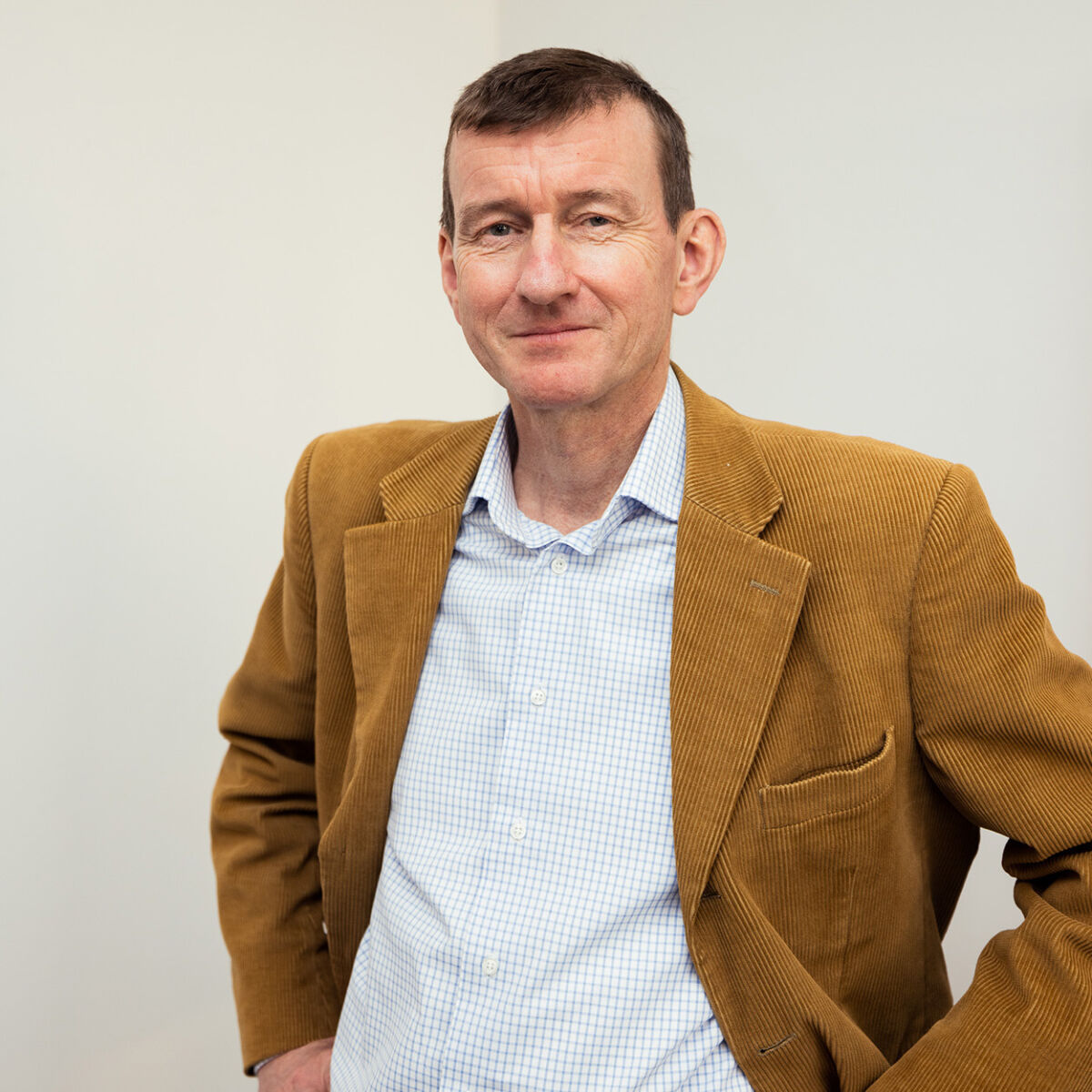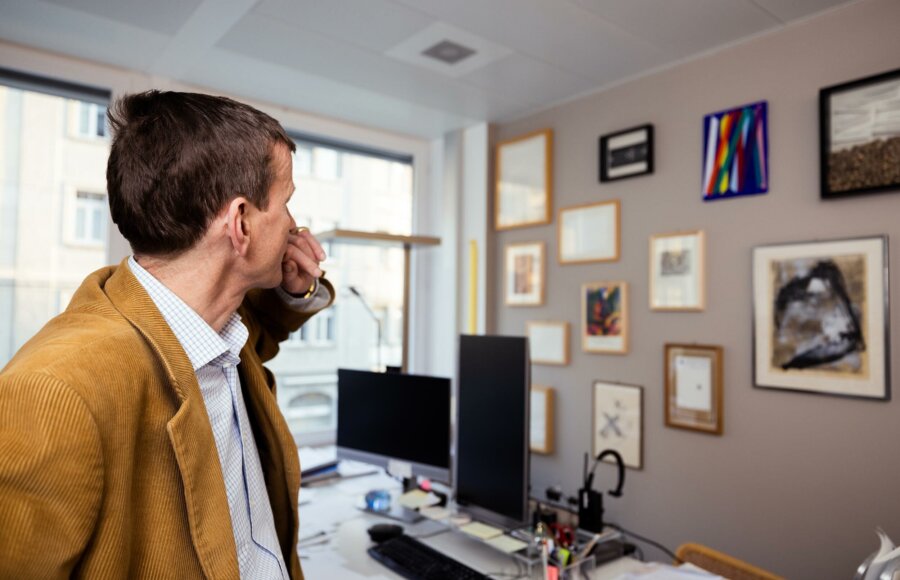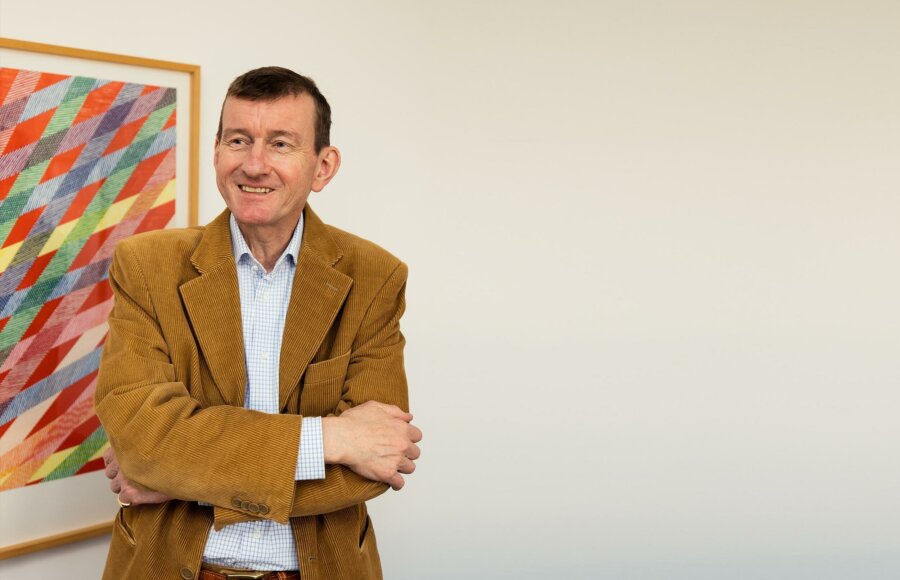
Mark A. Reutter curates the art at Walder Wyss’ headquarters in Zurich. Touring the office building is a visit to Reutter’s personal imaginary museum.
The only thing worse than screens are flipcharts next to artworks.
Anyone seeking legal advice at Walder Wyss will not miss Mark Reutter. He is present at reception and on all four floors of the office building – sometimes in colour, sometimes in black and white, sometimes very large and sometimes very small.
Mark Reutter has been working at Walder Wyss for nearly 30 years. He is a lawyer and art lover. Everything hanging in the building, in meeting rooms, hallways, in lawyers’ offices, above the table football in the cafeteria, in reception and in the post room is almost without exception his personal selection. And if there is nothing hanging in a meeting room, it is because of him. In the increasingly wired office architecture, he says there is no place for art. “We need screens on the walls.” The only thing worse than screens are flipcharts next to artworks.

Mark Reutter likes art and walls. He likes gags and cucumbers (more on that later). What he does not like is the screen-dominant office architecture that displaces art, and pictures that are hung crookedly. “That upsets me,” he says. Reutter is standing in the doorway of his office on the first floor, the starting point for our exclusive tour through the Walder Wyss Gallery. It is striking that there is just one wall for art in Reutter’s office; the others are shelves, windows or a glass partition.
It is also striking that not only does Reutter know his art and artists, but that they know him. The dedications on the artworks reveal that he is friends with many of them. They rarely just say “for Mark Reutter” – normally a few personal words are added to the signature. “In friendship”, for example, or “in solidarity”. On a poster by Hans Hartung, the dedication is written on a piece of paper and stuck between the artwork and the glass. On the back, “you must know” is the menu from the exhibition preview, entrecôte with bearnaise sauce, remembers Reutter, from 29/9/74.
«My opinion about a work of art is a gut feeling».
Walder Wyss and art have belonged together since the firm was founded in 1972. Mark Reutter says he chose the firm back in the 90s because the then partners had an “impressive art collection”. “I thought it was a privilege to work amongst such art.” When those partners left, it fell to Reutter to fill the gaps on the walls.
Today, there is hardly any space left on the walls in the building on Höschgasse. Reutter has filled the walls with graphics, posters, lithographs and several installations by Günther Uecker, whilst the shelves are filled with objects – and always with gags. One such gag is a time preserver. “I think it is funny in a law firm that sells hours to its clients.” Or one of the newest works in the collection: it is a blend of art and gag that hangs at the entrance to the post room, and was made by Reutter himself. He recently bought a sheet of the special series “Kunstsammlung der Post” (Art Collection of the Post Office) from the post office, which were printed on canvas, drew the stamps individually and framed them. He likes the idea, particularly at the law firm’s post room. You can see it in the challenging look he gives his interviewer, a certain mischievous glint in his eyes.

Mark Reutter grew up in St. Gallen, and you can still hear it. His second home soon became the Erker press and gallery in St. Gallen, which was run by friends of his parents. He spent a lot of time there as a child, watching how lithographs were made and enjoying being surrounded by art and artists. Later, he gave up his secondary school job as a night security guard at Securitas because he was given the opportunity to clean the gallery and carry out archiving tasks on Wednesday afternoons and Saturdays. He thought it was much better than walking around art-less offices at night.
As he tells this story, you can imagine how he could be the last to leave the office at night and how he would wander the corridors like a guard, enjoying the art in peace – and then turning off the lights, contented.
Walder Wyss and art have belonged together since the firm was founded in 1972.
Reutter’s approach to art is pragmatic. This can be seen in the series by the American artist Laura Owens that hangs on one floor. Reutter cut them out of the 2013 Ringier Annual Report and framed them himself in the basement of the office. “The silkscreens are the highest quality, why not hang them?” He is not a theorist, he repeats, “My opinion about a work of art is a gut feeling.”
This means that the line between good and bad is very sharply drawn at Walder Wyss. What Mark Reutter likes and does not like, what is good and what is bad, is non-negotiable. He has to live with the fact that there are colleagues who know nothing about art. Like, for example, the person – “I have a strong suspicion, but they are not confessing” – who every other day stuck a post-it note to Not Vital’s bronze cast cow patty: “This is really shit.”
«How to Work Better»
Mark Reutter’s tip for the art of good work: the artwork “How to Work Better” by Fischli/Weiss from 1991. He looks at it every morning.
«Is this art or can it go?»
That Reutter enjoys a certain reputation within the firm is shown by the following anecdote: during a lunch break, Reutter went shopping at the Coop next door. One of the items he bought was a cucumber for the evening meal, but as his wife discovered, it did not make it home. The next day, Reutter found the cucumber on the floor in his office. Next to it there was a note from the cleaning staff: “Is this art or can it go?”
Mark A. Reutter
is a partner in the Zurich office and has been working at Walder Wyss since 1994. His areas of expertise: technology, communication, culture and art. His passion: art. He is a dedicated art lover and has left his mark on the Walder Wyss office in Zurich with countless works of art. His unusual practice: he closes each of his talks with a work of art and relates it to the topic being presented.